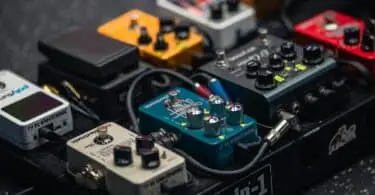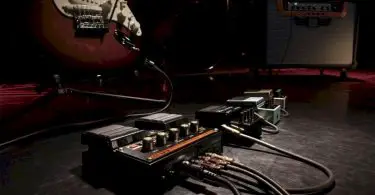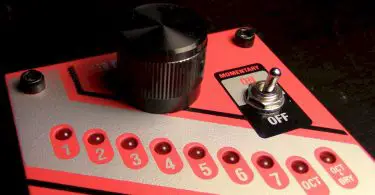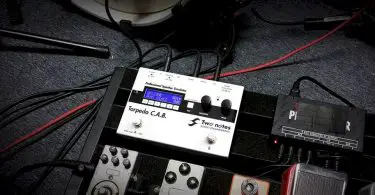The amplifier defines the tone of your instrument. While a great guitar might not sound that great when played through a cheap amplifier4, there’s a chance that a good amplifier will make a shoddy guitar sound like a high-end one.
However, a good amplifier is expensive. Things get even more expensive when you start talking about amplifiers that output specific tones, such as vintage amps. But this doesn’t mean that guitar players have to shell out their hard-earned cash in order to achieve the tone they’re looking for.
Amp-in-a-box pedals get pretty close to the tone of the real deal without breaking the bank. They’re a great alternative for players on a budget who are trying to achieve a particular tone.
In this article, I’m going to review five amp-in-a-box pedals to figure out what’s the best way of sounding great while keeping everything cost-effective.
When you buy through links on our site, we may earn an affiliate commission. As an Amazon Associate I earn from qualifying purchases.
Quick Links
Best Amps in a Box Pedals — Comparison Table
- JHS SuperBolt V2 Overdrive Guitar Effects Pedal
- Excellent sound quality
- Mellow and fuzzy or loud and aggressive
- Sounds just like a ‘60s amp
- Catalinbread SFT Overdrive Guitar Effects Pedal
- Stones/Stoner mode brings versatility
- Sounds like a vintage Marshall amp
- Great sound quality
- Wampler Pinnacle Standard V2 Distortion Guitar Effects Pedal
- Overdrive and distortion modes
- Great for achieving a brown tone
- Friedman Amplification BE-OD Overdrive Guitar Effects Pedal
- Very versatile
- Forces you to enhance your technique
- Excellent British tones
- Xotic Effects SL Drive Distortion Guitar Effects Pedal
- Plexi tone
- Effortlessly simulates vintage Marshall amplifiers

➡ Drive knob which acts as a volume knob
➡ Tone control usable throughout the entire range
➡ Converts 9V to 18V internally

➡ Switches between ‘70s amp sound and modern sound
➡ Uses either a 9V or an 18V power supply
➡ Baxandall tone stack

➡ Two distinct gain styles
➡ Increases gain and overdrive

➡ British overdrive tones
➡ True bypass switching
➡ Uses either an 8V or 18V power adapter

➡ Super Lead and Super Bass British sound
➡ Amp-like response
➡ Woody, organic sound
Best Amps in a Box Pedals Review
1. JHS SuperBolt V2 Overdrive — Best Amp Simulator Pedal
- Excellent sound quality
- Mellow and fuzzy or loud and aggressive
- Sounds just like a ‘60s amp
➡ Drive knob which acts as a volume knob
➡ Tone control usable throughout the entire range
➡ Converts 9V to 18V internally
Let’s get one thing out of the way: the JHS SuperBolt V2 is not a cheap pedal. Its price might disappoint you, and it’s understandable if you’re on a budget. However, if you can afford it, this pedal is probably the best amp simulator pedal money can buy.
There’s a reason why the SuperBolt V2 costs that much, and no written review is going to give you the same feeling you’d get by listening to it. This ‘60s amp simulator has a tone that goes toe-to-toe with a real amplifier.
There are only three knobs and a gain switch, yet the tonal range of this pedal is extensive. Just as the SuperBolt can give you a slight, mellow fuzz for the calmer songs, it can also output an aggressive crunch that preserves the entire tonal range of your guitar.
Cheaper pedals often lose the higher and lower ends in their circuit and output a choppy and muddy version (plus the pedal’s effect) of the actual guitar tone. That’s not the case with this pedal. The sound quality remains superb, no matter how far you crank the distortion.
It’s expensive, but once you play with it, you understand why and stop having a problem with its price tag. If you’re looking for the best amp-in-a-box pedal, then this is probably it.
Can you use an 18V adapter with this pedal?
No. This pedal uses a 9V adapter, which it then converts into 18V.
Who this is for?
Someone looking for the best of the best when it comes to amp-in-a-box pedals.
Why I like it?
The SuperBolt V2 sounds great any way you use it.
2. Catalinbread SFT Overdrive
- Stones/Stoner mode brings versatility
- Sounds like a vintage Marshall amp
- Great sound quality
➡ Switches between ‘70s amp sound and modern sound
➡ Uses either a 9V or an 18V power supply
➡ Baxandall tone stack
The Catalinbread SFT really nails down the vintage tone you’d expect from an old-school Marshall amp. It’s a great pedal for light overdrive5 and fuzz — and it doesn’t disappoint either when pushed to the max.
The pedal has a switch in the middle that alternates the mode between “stones” and “stoner.” The Stones mode, perhaps as the name suggests, outputs a very Rolling Stones-like tone — a deep, overdriven, rich tone that reeks of the ‘70s.
Turn the Stoner mode on, and you’ll get a tone that feels like stoner rock. Fans of Queens of the Stone Age will definitely recognize the tone as something very Josh Homme-like.
The worst thing about this pedal is the position of the Stones/Stoner switch. Since it’s tucked away in a hard to reach the place, switching between the two modes while playing is almost impossible. You’ll have to decide which tone you want before you start playing.
Who this is for?
Someone who likes the classic Rolling Stones tone but also wants the versatility of having something with a more modern sound as well.
Why I like it?
This pedal combines vintage and modern to a great effect.
3. Wampler Pinnacle Standard V2 Distortion
- Overdrive and distortion modes
- Great for achieving a brown tone
➡ Two distinct gain styles
➡ Increases gain and overdrive
Players looking for a brown tone, similar to that of Eddie Van Halen, will definitely love the Pinnacle Standard V2.
This is not a versatile pedal. There aren’t many different tonal styles to achieve, even though there are four knobs and two switches. However, the Pinnacle Standard V2 excels at high gain, overdriven tones.
One of the switches on the pedal controls the gain structure. You can switch between a more distorted or overdriven gain structure, which sounds distinct enough but aren’t something to write home about. The second switch turns on the vintage setting, which adds a little old-school flavor to your tone.
Can you use a battery with this pedal?
No. This pedal uses an 18V power supply.
Does this pedal come with a power supply?
No. You will need to purchase the power supply separately.
Who this is for?
Someone looking for an Eddie Van Halen-like tone.
Why I like it?
Although it isn’t a very versatile pedal, the Pinnacle Standard V2 excels at what it does.
4. Friedman Amplification BE-OD Overdrive
- Very versatile
- Forces you to enhance your technique
- Excellent British tones
➡ British overdrive tones
➡ True bypass switching
➡ Uses either an 8V or 18V power adapter
Sure, this pedal has six different knobs. However, its tone doesn’t stray too far from the well-known vintage British overdriven tone.
The knobs let you control the EQ, the volume, and the gain. Regardless of what your preferred settings are, the result will most likely be a distinctive distorted tone.
For a British-style amplifier pedal, the BE-OD is very versatile. This pedal can be used for metal or for classic rock, with everything in between. The sound it produces is clear and has an excellent definition.
One thing can be seen as a negative, though, even though it isn’t — this pedal will force you to tighten your picking technique. If you bump ever-so-slightly an unintended string, this pedal will pick it up and make the error stand out.
Does the power supply come included with the pedal?
No, it doesn’t. You can use any 9 or 18V power supply.
Does this pedal has scooped mids?
No. Besides, you can control the mids through a dedicated knob.
Who this is for?
Someone who loves British tones and wants a versatile pedal.
Why I like it?
The BE-OD sounds great and is very versatile for a British-style pedal.
5. Xotic Effects SL Drive Distortion
- Plexi tone
- Effortlessly simulates vintage Marshall amplifiers
➡ Super Lead and Super Bass British sound
➡ Amp-like response
➡ Woody, organic sound
They say the best things come in small packages. Regardless of whether that is true or not, the truth is the SL Drive brings a lot of tone in a very compact size.
This pedal effortlessly simulates vintage Marshall tube amplifiers. You wouldn’t suspect it by looking at it, but this pedal will give you the same tone as an expensive Plexi amplifier.
There aren’t many settings to fiddle around with, but there’s no need to. This pedal excels at one thing and one thing only. If you can’t afford an old school Marshall amplifier but want its sound, then you should look no further than this pedal.
Who this is for?
Someone who loves the old school Marshall tone.
Why I like it?
This small pedal brings a lot of tone to the table, it’s impossible not to like it.
Wrapping Up
Amp-in-a-box pedals6 can take your tone to the next level without costing you an arm and a leg. They’re great when paired with inexpensive gear and are even better when you bring out the big guns.
Some of these pedals might seem a little too expensive. However, when you realize that you’re basically getting a high-end vintage amplifier inside a small pedal, you understand the reasoning behind the price tag.
If you can afford this type of pedal, then the JHS SuperBolt V2 Overdrive is an excellent choice. This pedal is very versatile and sounds great. Every other pedal in this list is good as well and will definitely improve your guitar-playing experience.
Best Amps in a Box Pedals — Buyer’s Guide and Tests
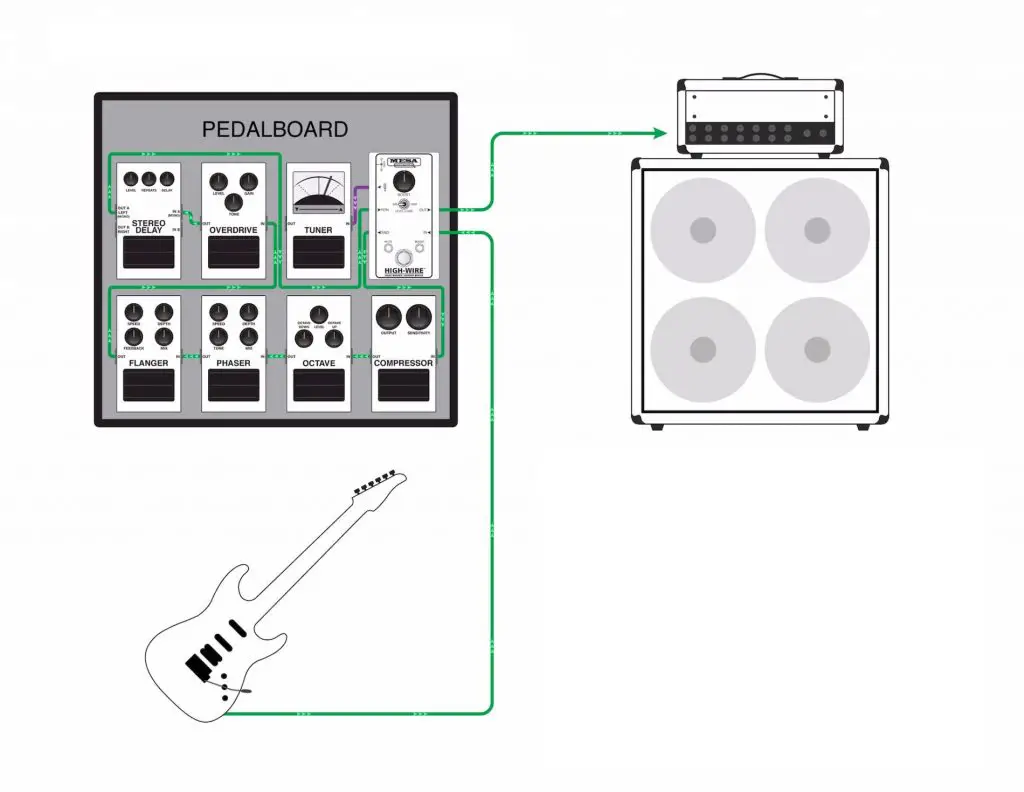
Amps in a Box Pedals Setup
Friedman Amplification BE-OD Overdrive pedal test
Friedman Amplification quickly left the status of an insider tip for tube amps and created an almost legendary amp with the BE-100 Brown Eye, a hand-wired all-tube top in a boutique environment. Like many other amp manufacturers, Friedman is trying to squeeze the sound of his vehicle into a floor pedal. The BE-OD Overdrive/Distortion is screwed together in the USA. It is supposed to generate the creamy tone of the BE-100 at the push of a button.
Details
The BE-OD comes in a sturdy, black painted metal housing in standard size (72 x 120 x 59 mm), comparable to the usual MXR pedals.
On the top side, there are six double rowed controls for adjusting the distortion sound. Besides, a small trim pot inside the pedal is waiting for you to adjust the basic setting of the distortion level in nuances. This pot is set to 12 o’clock at the factory, so there is enough room for maneuver in both directions. After unscrewing the cover, it can be operated with a small screwdriver. As usual, the top side features a footswitch and a corresponding status LED. Dave Friedman has given the pedal a true bypass circuit, so the input signal is routed directly to the output when the pedal is not activated.
The BE-OD can be flexibly supplied with voltages between 9 and 18 volts, but battery operation is not possible. Since most guitarists now feed their floor pedals on the board with a multiple power supply, this is not so dramatic in my eyes. The connectors are parked on both sides by default, left the output, right the input, and the pedal makes a robust, roadworthy impression. The BE-OD is made in the USA but contains premium components from all over the world. Therefore the price of the pedal is in an entirely normal range for a boutique product.
Operation
For adjustment, the upper row of controls provides a tone control consisting of Bass, Treble, and Presence. The Presence control gives the very high frequencies an additional shine. The second row comes with Gain, Volume, and Tight. The latter provides clarity in the bass range. The further it is turned up, the tighter the notes of the low strings come out of the speakers. So much for theory, practice calls!
Practice
The BE-OD is now in front of my cleanly adjusted Sovtek MIG-50H. First of all, the control path of the distortion degree is tested with the Les Paul. It can be used in the complete range. Even with the minimum setting of 7 o’clock, there is something to hear. The circuit is constructed in a way that even with higher gain settings, the volume doesn’t increase drastically, so you don’t have to adjust the master when the distortion level changes significantly. This makes it a bit easier on stage if you like to adjust the gain. The range of the distortion is not very high. If you have a guitar with humbuckers at the start, there is already in the minimum setting a hearty mid-gain board, which then develops in the course of the control path to a rich high-gain distortion. (Ex. 1)
With a single-coil guitar, it is possible to get crunch sounds out of the BE-OD with minimal gain. Of course, the distortion level can be adjusted at the internal trim pot – the efficiency is quite high. I experimented a bit at the beginning, but quickly got back to the factory setting of 12 o’clock, because the construction of the pedal aims at high distortion levels, and these are handled very well here. Even a Strat can come out of the speakers with a lot of taste (Ex. 4).
The only downer is the higher level of background noise, and here Dave Friedman is a bit more generous, this was already quite high with the BE-100 amp. If you are fussy in this respect, you should get a Noise Gate. The tight control is very effective, with which the bass range can be adjusted more crisply. Riffs on the low strings get a much better assertiveness in higher settings, which is especially crucial for high-gain sounds. You can hear the span with the minimum and maximum value. In example 2 and in example 7 you can hear the BE-OD with a baritone guitar in drop-A-tuning. There, the high setting of the Tight knob creates enormous transparency in the frequency cellar.
But also, in general, you can attest to the BE-OD a very transparent sound. This is also the point where the pedal differs from many others that also produce high-gain sounds. Because the BE-OD has a clean string separation, and chords are transferred cleanly even in high gain settings. In example 6 I played a few “Jazz Chords” with such a setting, which are audible despite the distortion.
However, the pedal does not necessarily have a sensitive dynamic response. Others have a more sensitive command of this discipline. But in principle, I don’t find this so dramatic, because the BE-OD is designed as a special tool for sawing, and that’s what it does the first class. The tone control allows with Treble and Presence control an excellent fine-tuning in the upper-frequency range, so primarily the classic rock sounds are the order of the day here. Because of the sound transparency and the degree of distortion, I think the BE-OD is also suitable for metal. Here you would have to put a graphic EQ behind the pedal and edit the mids accordingly. In the last example, you can get an impression of the sustain and overtone behavior of the pedal. The sound responds very well to pinch harmonics, and even at low volume it already tips over into the overtone range. During the recording, I had elevated room volume in the control room. The studio monitors generated slight feedback.
Example 1: Gain control: 7, 9, 12, 15, 17 o’clock (Les Paul)
Example 2: Tight control: minimum and maximum (Les Paul)
Example 3: Minimal Gain (Strat)
Example 4: High Gain (Strat)
Example 5: High Gain Punkrock Style (Melody Maker)
Example 6: High Gain Jazz Chords (SG)
Example 7: Baritone guitar with Drop A-Tuning
Example 8: Lead Sound with Reverb (Les Paul)
Verdict
The BE-OD produces a rich distortion sound of the highest quality. However, it should be clear to everyone that this pedal is not an egg-laying wool-milk sow, but rather belongs in the category “special tools”. It delivers a creamy distortion with lots of gain and significant transparency. Even at high settings, you can hear every single note on all six strings of chords. What is not necessarily a specialty is the dynamic response. The degree of distortion can only be moderately controlled with the attack or the volume pot on the guitar. Instead, it provides rich sustain and excellent overtone behavior. The BE-OD serves all facets of mid-gain to high-gain sounds in classic style and more than lives up to its role model, the sound of a pimped out Marshall. The only drop of bitterness is the increased amount of background noise, for which you get a half star deduction, but apart from that, the pedal is the hammer, even at the price called.
- https://ccrma.stanford.edu/~dtyeh/papers/DavidYehThesissinglesided.pdf
- https://en.wikipedia.org/wiki/Distortion_(music)#Overdrive/distortion_pedals
- https://web.wpi.edu/Pubs/E-project/Available/E-project-090208-113049/unrestricted/MQPFinalReport.pdf
- https://ccrma.stanford.edu/~dtyeh/papers/DavidYehThesissinglesided.pdf
- https://en.wikipedia.org/wiki/Distortion_(music)#Overdrive/distortion_pedals
- https://web.wpi.edu/Pubs/E-project/Available/E-project-090208-113049/unrestricted/MQPFinalReport.pdf

